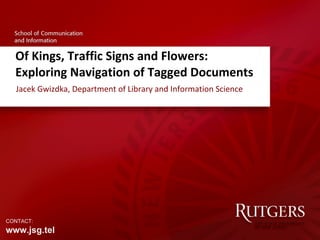HT2010 Paper Presentation by Jacek Gwizdka
- 1. Of Kings, Traffic Signs and Flowers: Exploring Navigation of Tagged Documents Jacek Gwizdka, Department of Library and Information Science CONTACT: www.jsg.tel
- 2. Process of Tagging http : //bit.ly/tagtrails
- 3. Process of Tagging and Tag-space Users associate tags with web resources Tags serve in social, structural, and semantic role structural role: starting points for navigation; helping users to orient themselves semantic role: description of a set of associated resources Tag space: set of web resources with associated tags (descriptors) many-to-many relationships
- 4. An Example of Navigation (CiteULike) information ’āĀ retrieval ’āĀ algorithms ’āĀ phylogeny
- 5. An Example of Navigation (CiteULike) Pivot browsing: a lightweight navigation mechanism; users reorient view Each navigation step is treated as separate At each step context is switched Relationships between steps are not shown e.g., overlap between tag clouds not indicated 1. information ’āĀ 2. retrieval ’āĀ 3. algorithms ’āĀ 4. phylogeny
- 6. Research Questions How can we support continuity in ŌĆ£tag-spaceŌĆØ navigation? How do people understand navigation in tag-space?
- 7. User Interface with ŌĆ£History tag cloudsŌĆØ (Tag Trails) Supporting continuity in tag-space navigation by providing history information ’āĀ retrieval ’āĀ algorithms ’āĀ phylogeny History tag clouds
- 8. User Interface with Heat map (Tag Trails) Supporting continuity in tag-space navigation by providing history and making (some) relationships (more) explicit Tag cloud Results list Column-tags: most recently visited tags from left to right Row-tags: selection of most frequent tags Cells color-coded according to tagŌĆÖs df Heat map
- 9. Navigation History and Relationships in Heat map
- 10. User Study Exploratory study 10 study sessions each with a pair* of participants 18 participants working in pairs 3 tasks, each using a different variation of the interface data set from CiteULike (also deli.cio.us) paired talk aloud protocol interaction log and screen cam recorded debriefing interview draw what they experienced using physical world analogies
- 11. User Interfaces
- 12. Results focus on qualitative results
- 13. The Kingdom Hierarchical relationship between tags
- 14. The Space Notion of distance Navigation ŌĆō movement in one direction: to weaker associations Relative to the initial tag
- 15. The Labyrinth Location, movement, distance
- 16. Location, movement, distance The Journey
- 18. The Conversation Topic drift
- 19. User Expectations Successive navigation steps related to the initial tag if the initial tag missing, a few users restarted the process ŌĆ£ SearchŌĆØ results narrowed down
- 20. Summary & Conclusions Users experience ŌĆ£switchingŌĆØ, yet expect some continuity Pivot browsing seems to be conceptually not lightweight conceptualizing multiple tags assigned in different quantities to different documents is difficult Users may be (to some extent) misunderstanding navigation in tag-spaces Future work: support navigation continuity simplify user interface, two alternatives: a tag cloud based on some formula that incorporates previously ŌĆ£visitedŌĆØ tags a further developed heat map Study limitations include: a small sample; a short time ; a perhaps atypical task for a tag-based navigation
- 21. Thank you! Questions? Jacek Gwizdka , School of Communication & Information, Rutgers U. CONTACT ht2010@gwizdka.com & http://jsg.tel MORE INFO http://bit.ly/tagtrails
- 22. Bonus slides
- 23. User Interface with the Heat map - Tooltip
- 24. Interface with a heat map and history tag clouds























